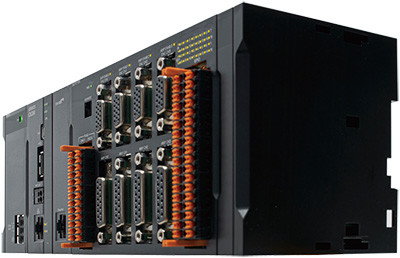- Home » News » Technology News
Multi-axis controllers offer ‘world-beating’ output speeds

Omron has announced a programmable multi-axis controller that, it claims, delivers “world-beating” output speeds of 16.6µs per axis (or 50µs for five axes). The CK3M controller is designed to achieve nanoscale motion control to meet the future manufacturing needs of the semiconductor and automotive industries.
Omron has developed the controller by combining the motion control capabilities of the PMAC (programmable multi-axis controller) technology originally developed by US-based Delta Tau Data Systems – which Omron acquired in 2015 – with its own technologies.
Omron explains that semiconductor devices are increasingly being miniaturised and created as 3D structures. And in the automotive industry, component shapes are becoming more complex, and being made from a wider variety of materials. To handle these components, machines need precise positioning and path control that can be achieved through synchronised control of high-resolution encoders, motors, and other devices.
However, with conventional controllers that can connect only to specific devices, fully synchronised control is difficult to achieve because separate controllers are needed for each device. Machine-builders therefore have to develop their own control boards and incorporate their own control algorithms. They also face a “huge cost burden” because of design changes caused by parts being discontinued.
Omron says that the new controller can solve these problems by providing connections to almost any type of motor or encoder using EtherCat and encoder protocols. This means that only one controller is needed for high-speed synchronous control. Moreover, using Ansi C or original programming languages allows machine-builders to create their own control algorithms.
The controllers can interface with various encoders and motors, providing precision synchronous control and enhancing machine performance. High-speed feedback control allows precise path control for precision machining.
Using Ansi C or original programming languages will allow machine-builders to create complex and advanced algorithms. The controllers can provide full closed-loop control by servodrives. Users will also be able to customise machine control functions, such as vibration suppression, that are optimised for their machines.

After a limited release for specific customers earlier this year, the CK3M controllers are now being released globally.
The controllers fit in with Omron’s recently announced strategic concept, known as innovative-Automation!, which is based on three key innovations aimed at enabling significant productivity improvements in manufacturing to achieve high-value-added manufacturing. The three innovations – or “i's” – are:
• “integrated” (control evolution) so that almost any operator, even with little experience, can perform work that previously required the expert skills of experienced workers;
• “intelligent” (development of intelligence by ICT), to create constantly evolving equipment and production lines. By adopting a wide range of control devices and artificial intelligence (AI), machines will learn through experience and maintain themselves in optimal condition.
• “interactive” (harmonisation between people and machines), to develop a harmonious relationship between human operators and machines. Working together in the same space, machines will be able to assist human operators by recognising human thoughts and behaviour.





